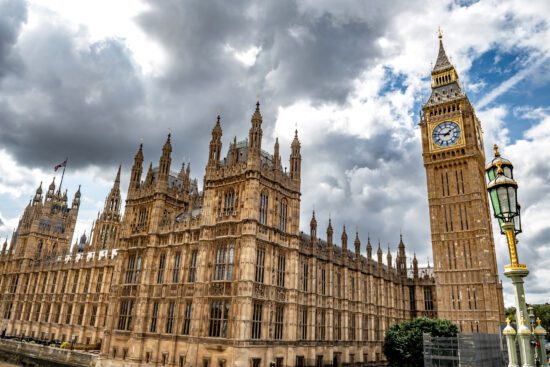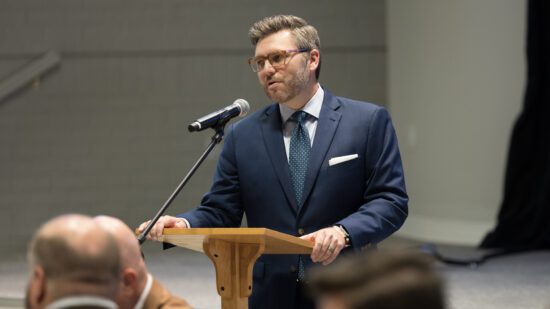The Benedict Option—a proposal for how Christians might live in a post-Christian culture—has proven to be a Rorschach test: everyone seems to see something different in it. Perhaps these variations owe, in part, to the development of the idea over several years under public scrutiny, accompanied by spirited discussion. The idea is finally put forward in full with the March 14 publication of the book by Rod Dreher, writer and columnist for The American Conservative. Because of the ample criticism and commentary that have been offered along the book’s way, it might be most helpful simply to look closely at what The Benedict Option is—and isn’t—proposing.
Understanding the title goes a long way toward understanding the concept. “Benedict” refers, of course, to the sixth century founder of a monastic order established during the swirling cultural chaos of the falling Roman Empire. Dreher turns to Benedict to pick up on a suggestion made by moral philosopher Alasdair MacIntyre in his 1981 book, After Virtue. MacIntyre points to Benedict as a model from the past for our current culture, which no longer sees virtue as essential to a flourishing civilization. “Option” is a twist on Rule, the name of the guidelines Benedict developed for godly and communal living in the monastery. Dreher’s use of “option” is an implicit acknowledgment that everything in modernity is a matter of choice, right down to the very attempt to resist modernity.
The Benedict Option’s vision is not to make nuns and monks of modern Christians. Nor does it propose a bunker (whether literal or figurative) from which to establish merely an updated version of the fundamentalist separatism of yore. Nor is the turn to Benedict a quixotic attempt to recapture a romanticized past.
To the contrary, The Benedict Option calls Christians wherever they live and work to “form a vibrant counterculture” by cultivating practices and communities that reflect the understanding that Christians, who are not citizens of this world, need not “prop up the current order” (18). While the monastery that birthed the Benedict Rule was literal, the monastery invoked in The Benedict Option is metaphorical. It is not a place, but a way.
Dreher explains:
We are only trying to build a Christian way of life that stands as an island of sanctity and stability amid the high tide of liquid modernity. We are not looking to create heaven on earth; we are simply looking for a way to be strong in faith through a time of great testing. (54)
The first two chapters of the book outline the historical and cultural forces that have brought us today to what Dreher terms anther “great flood”: a destructive, secularized culture growing increasingly hostile to Christianity and religious liberty. Christians are mistaken, Dreher argues, drawing upon the work of Charles Taylor, if we think we are standing apart from the culture of this secular age. For we are “as much creatures of our own time as secular people are” (44-45). Therefore,
We should stop trying to meet the world on its own terms and focus on building up fidelity in distinct community. Instead of being seeker-friendly, we should be finder friendly, offering those who come to us a new and different way of life. It must be a way of life shaped by the biblical story and practices that keep us firmly rooted on the truths of that story in a world that wants to obscure them and make us forget. (121)
The heart of The Benedict Option is the third chapter of the book. Here, after describing the order of St. Benedict and his Rule, Dreher draws from the Rule to identify and adapt principles that we in the church should apply within our modern context:
- Order: recognizing and establishing inner order that is in harmony with the natural limits and ultimate reality created by God
- Prayer: making communication with God through prayer and scripture the basis of daily life
- Work: recognizing that work is not separated from the spiritual life and must glorify God
- Asceticism: resisting the materialism, consumerism and hedonism that drive modern culture and inhibit the spiritual life
- Stability: putting down deep roots where we live, work and worship
- Community: prioritizing fellowship with others over individual interests and freedoms
- Hospitality: being as open to the world as is possible without compromising orthodox faith
- Balance: practicing the prudence necessary to balance not only right and wrong, but competing goods
The beauty of these principles is that they can be adopted by nearly any Christian individual or community, regardless of denomination, ethnicity, socio-economic status or location. Some, certainly, speak more to those in positions of privilege or power. But it is perhaps the most oppressed among us who demonstrate the transforming power inner order has within the harshest of conditions. These principles not only bring internal order, but knit communities together, as well as create new bonds among those who share them. The rest of the book’s chapters detail how these principles can be applied to various spheres: politics, churches, local communities, educational institutions, workplaces, families and technology.
Dreher cautions throughout the book against ways that foster the isolationism which, ironically, contributed to the hostile culture Christians now find themselves in. So even as he offers strategies for strengthening families and communities, he sounds a clear warning against idolizing these institutions, for to do so leads to tyranny and rebellion. Further, Dreher encourages building relationships across church lines, noting that “a community too rigid that it cannot bend will break itself or its members” (138).
The Benedict Option attempts to apply the principles of The Benedict Rule to a vastly different world for the same purpose they served in the ancient monastery: to help Christians order our lives “to be as receptive as possible to God’s grace, both individually and in community” (47).
The book begins with the bad news of a coming flood of cultural decline, one forewarned by several generations of Christian thinkers. But it doesn’t end there. Just as with the biblical flood, the church today is to be, not only an ark, but a wellspring, Dreher writes. The church is the place where water allows us to “drown our old selves symbolically” (238).
Many discussions—and more than a few controversies—have developed leading up to the book’s publication. Some think Dreher’s diagnosis too dire. Some think his prescription too outdated.
The real Rorschach test isn’t what we see in The Benedict Option itself, but rather what we see in the inkblot of current culture. Some see an America hell bent on breaking the church. Some see a church in a nation that is no less hostile than the church has found itself in for most of its history.
Yet, the principles The Benedict Option offers as part of a “strategic withdrawal” from “liquid modernity” are as timeless as they are timely. As one adherent interviewed in the book observes, “[T]his strategy is not a new thing at all; it only seems so because we have forgotten how to act like a community instead of a random collection of individuals.” She continues, “It’s just the church being what the church is supposed to be” (142).
If this is the case, then it’s really not an option.










